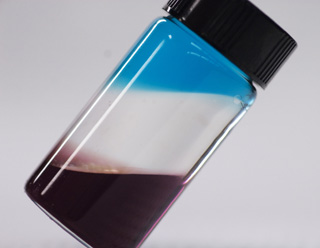-

-
Courses
Find courses by:
Collections
- About
- Donate
- Featured Sites
This is an archived course. A more recent version may be available at ocw.mit.edu.

This vial containing three immiscible liquids – that is, liquids that cannot be mixed – demonstrates how the chemical components of a liquid metal battery can self-assemble. When the vial is shaken, the liquids separate after a few seconds.
Prof. Donald Sadoway
3.091
Fall 2004
Undergraduate
For a video introduction to Professor Sadoway’s perspectives on teaching, research, inspiration and invention, see “What I Learned in 3.091 Was All I Needed to Know” in Related Resources.
This course explores the basic principles of chemistry and their application to engineering systems. It deals with the relationship between electronic structure, chemical bonding, and atomic order. It also investigates the characterization of atomic arrangements in crystalline and amorphous solids: metals, ceramics, semiconductors, and polymers (including proteins). Topics covered include organic chemistry, solution chemistry, acid-base equilibria, electrochemistry, biochemistry, chemical kinetics, diffusion, and phase diagrams. Examples are drawn from industrial practice (including the environmental impact of chemical processes), from energy generation and storage, e.g., batteries and fuel cells, and from emerging technologies, e.g., photonic and biomedical devices.